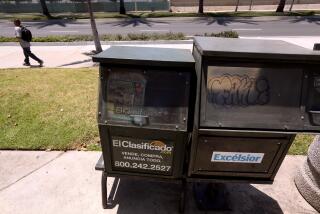A Cure for Static Radio
- Share via
Bored listeners are begging for alternatives to the sameness and repetitiveness of commercial radio today. The big chains like Clear Channel Communications, recognizing the disaffection, have responded with a few faux-independent stations that play quirky or political music that other chain stations won’t touch. More Polyphonic Spree, less Limp Bizkit. They’re trying to duplicate the intimacy and individuality of the old local stations. So why not allow the real thing, embodied in low-power FM broadcasts?
The big broadcasters, even the big public broadcasting networks, hate the idea and have repeatedly killed proposals in Congress to encourage hyperlocal stations that might be run by churches, schools or fan clubs. Sen. John McCain (R-Ariz.), chairman of the Senate Commerce Committee, is giving it one more try with a vote Thursday on S 2505, by himself and Sen. Patrick Leahy (D-Vt.). Just last week, McCain thought he had enough support to pass the modest measure, authorizing the Federal Communications Commission to approve as many as 1,000 low-power FM stations. That was before the National Assn. of Broadcasters stepped up its lobbying against low-power FM, which it fears could pressure the Power 107s, Lite FMs and other broadcasters to produce more local content.
Radio is what it is today is largely because of the Telecommunications Act of 1996, which removed caps on the number of local stations that broadcasters could own in a single market. Clear Channel now owns 1,165 stations in 45 of the top 50 U.S. markets. Infinity Broadcasting is its closest competitor, with 186 stations in mostly major markets.
In the late 1990s, then-FCC Chairman William Kennard proposed permitting mini-stations with transmitters under 100 watts and ranges under 3.5 miles. Big broadcasters cried foul and pressed the FCC to hire the Mitre Corp.-- an established technology consultant -- to determine whether low-power stations would interfere with their signals. When the report concluded this year there would be no interference problems and there was no reason to delay the smaller stations, the National Assn. of Broadcasters called the study “deeply flawed” -- even though the broadcasters helped design it.
Low-power FM could please almost endless little audiences, with no damage to Big Radio except for a smidgen of competition. The groups that support it include the United Church of Christ and the Future of Music Coalition, which seeks outlets for musicians who can’t get record contracts.
If S 2505 can make it out of committee, it stands a decent chance of becoming law. With the Mitre report’s well-documented conclusion that there’s room for both commercial and community voices, there’s no justification for holding up McCain’s bill.
More to Read
Sign up for Essential California
The most important California stories and recommendations in your inbox every morning.
You may occasionally receive promotional content from the Los Angeles Times.













